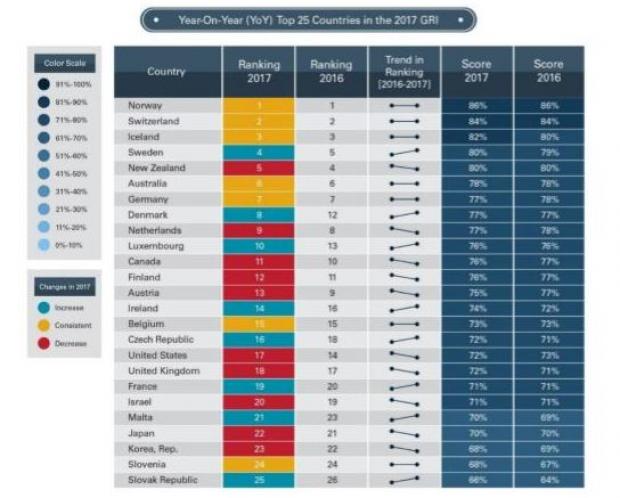A new global index of best practices by policy makers, employers and asset managers found that the United States is losing ground in providing economic and financial security and improved health care services to its 75 million baby boomers.
While more homogenous and much smaller Scandinavian and European countries lead the world in forging a sound and humane retirement policies, the United States ranked only 17th among 43 countries in shoring up retirement security, according to the fifth annual Natixis Global Retirement Index released on Wednesday.
Related: The Biggest Regret for People Approaching Retirement
The index provides an overall retirement security score based on 18 key drivers of retiree well-being across the four broad categories of finances, health, material well-being and quality of Life. The latest U.S. ranking is three steps below its global rating a year ago.
While the U.S. enjoys the fifth highest income per capita and pours more money into the health care system than any other country, the new global index highlights many troubling developments that are making the U.S. a more hostile environment for an aging population than before.
Among those are:
A growing income disparity between the ultra rich and the poor and middle class. The U.S. registered the sixth lowest score of any country for income inequality compared to the previous year in the “material well-being” category.
“The results suggest that millions of lower-income Americans are missing out on that economic growth and may struggle to save for a secure retirement as a result,” the report stated.
A BlackRock survey last year said the average baby boomer approaching retirement, defined as 55 to 65 years old, has $136,200 saved for retirement, a relatively modest amount. When additional savings and compound growth are factored in, that typically translates into $9,129 a year beyond Social Security and other pensions.
Related: The 25 Best Cities for Retirement
A lagging life expectancy despite arguably one of the best health care systems in the world. The U.S. spends more per capita on healthcare than any other country and has the sixth-highest score for insured expenditures on health. Yet, the United States ranked just 30th in life expectancy – failing to keep pace with top-ranked Japan and other countries. That suggests that “its health expenditures may not be yielding the same return on investment,” the report states.
This is a slightly skewed statistic because of America’s involvement in two wars and its ongoing opioid crisis.
Between 1980 and 2014, life expectancy at birth increased by 5.3 years for both men and women, from 73.8 years to 79.1 years. However, experts say the numbers aren’t the same everywhere, with substantial differences from county to county.
A mixed message of stability from financial institutions. The U.S. remained among the top ten countries in terms of strength and dependability of their financial institutions, largely because of improvements in bank “non-performing loans” and federal debt levels.
However, the U.S. has the seventh-highest public debt to GDP ratio of any country, as well as a growing adverse ratio of retirees to employment-age adults. That mismatch between the number of Americans working and paying taxes and retirees drawing down on entitlement benefits is putting added stress on the Social Security and Medicare Trust Funds, which are gradually running out of money.
Related: Trump’s Tax Plan Could Affect Your Social Security
At the same time, low-interest rates and tax pressures “negatively affect savings rates and income in retirement, according to the report.
Ed Farrington, executive vice president of retirement for Natixis Global Asset Management, said in a statement that the new index underscores the fact that retirement security “is a complex, multi-dimension issue that is vastly influenced by a nation’s policies, politics and economics.”
On a regional basis, the top 10 countries in the 2017 index include eight from Western Europe. Norway leads the way, followed by Switzerland, Iceland, Sweden, Germany, Denmark, the Netherlands and Luxembourg. New Zealand and Australia round out the group.
Residents of these countries benefit from a “combination of strong programs, widely accessible health care and low levels of income inequality.”
Related: A New Plan to Save Social Security for Another 75 Years
The study found that rapid growth of the elderly population is forcing many countries to rethink and revamp their public pension systems. Many pension managers “are under pressure as increased lifespans and a long period of historically low-interest rates had increased liabilities and created a funding shortfall,” according to the report.
Indeed, the world’s six largest pension savings systems, including that of the United States, are projected to reach a $224 trillion funding gap by 2010, according to a study by the World Economic Forum.
That concern about mounting unfunded liabilities has prompted significant changes in employer retirement plans. Many companies and organizations have frozen or jettisoned traditional plans and moved to “defined contribution plans” that shift the liability for retirement funding from the employer to the worker.






